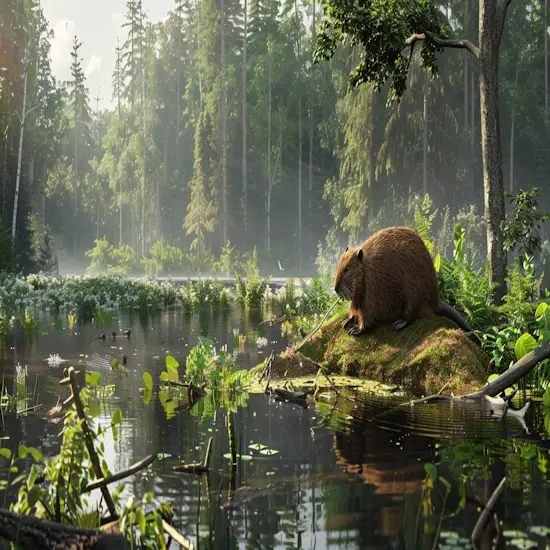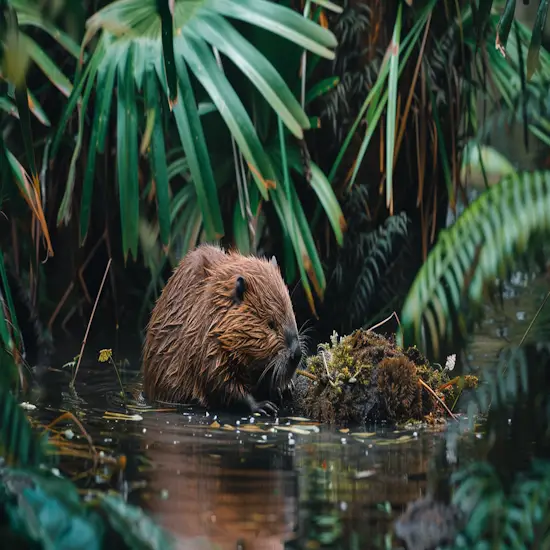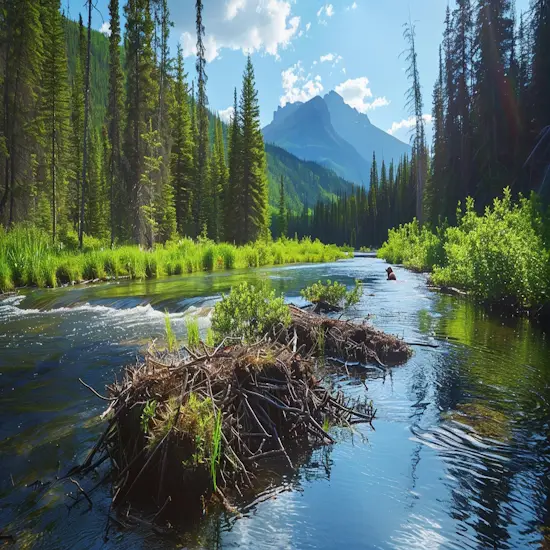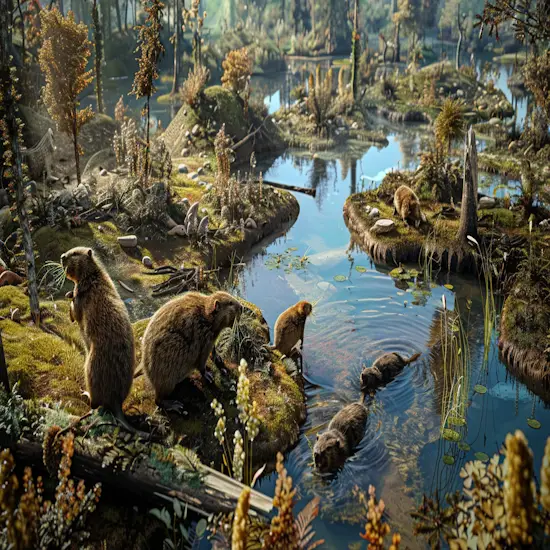Disclosure: We may earn commissions if you purchase products after clicking on a link from our site.
How are beavers important to the ecosystem? This might be a question you ask yourself as you read about beavers. Beavers hold a crucial role in maintaining the delicate balance of the ecosystem. Their activities reach far beyond mere dam-building and tree-chewing.
Beavers through their unique behaviors, contribute to the overall health of the environment in ways that might surprise you. In this article, we share information about how beavers are important to the ecosystem.

Table of Contents
Key Takeaways
- Beavers enhance biodiversity by creating diverse habitats.
- Their dams act as natural filtration systems, improving water quality.
- Beaver ponds increase ecosystem carbon storage, aiding in climate change mitigation.
- They create wetlands that support a thriving and balanced ecosystem.
- Beavers play a crucial role in protecting water quality and preventing floods.

Climate Change Warriors
Beavers are true climate change warriors by enhancing carbon storage, creating beneficial wetlands, and reducing atmospheric carbon levels.
Their ability to absorb and store carbon in wetlands plays a vital role in carbon capture efforts, making a substantial contribution to mitigating climate change.
Carbon Storage Enhancement
The contribution of beavers to carbon storage enhancement in ecosystems is significant in the fight against climate change. Beavers absorb and store carbon in their wetlands, reducing atmospheric carbon by 470,000 tons annually. This activity is valued at millions of dollars in carbon-capture work.
By restoring beavers to natural habitats, you can help increase carbon absorption. More beavers mean more wetlands, leading to less atmospheric carbon and aiding in climate change mitigation efforts. Beavers play an important role in enhancing carbon storage, which is essential for maintaining a healthy ecosystem and combating the effects of climate change. Their impact on carbon storage highlights their importance as climate change warriors.
Wetland Creation Benefits
Enhancing ecosystems through the creation of wetlands provides essential benefits in the fight against climate change. Wetlands created by beavers play a vital role in maintaining ecological balance by increasing biodiversity, improving water quality, and storing water during droughts. Below is a table highlighting the key benefits of wetland creation by beavers in combatting climate change:
| Benefits of Wetland Creation | Description | Impact |
|---|---|---|
| Increased Biodiversity | Beaver ponds create diverse habitats for various species. | Supports a thriving ecosystem. |
| Water Quality | Wetlands act as natural filters, cleansing pollutants. | Enhances the overall health of waterways. |
| Flood Risk Reduction | Beaver dams store water, minimizing flooding risks. | Protects surrounding areas from inundation. |
Atmospheric Carbon Reduction
Lowering atmospheric carbon levels is essential in the fight against climate change. Beavers play an important role in this battle by absorbing and storing carbon in their wetlands.
Globally, beaver wetlands hold 470,000 tons of carbon annually, contributing greatly to carbon capture efforts worth millions of dollars. By restoring beavers to their natural habitats, we can increase carbon absorption, aiding in climate change mitigation.
More beavers mean more wetlands, resulting in less atmospheric carbon. This natural carbon-capture work showcases the critical role beavers play as climate change warriors.

Guardians of Water Quality
Beavers act as guardians of water quality by serving as natural filtration systems. They capture sediment and nutrients, enhancing water clarity downstream. Their dams hold back sediment, allowing cleaner water to flow through, benefitting the ecosystem.
Through their habitat alterations, beavers contribute greatly to improving the overall water quality of their surroundings.
Natural Filtration Systems
Beaver dams serve as natural filtration systems in ecosystems, enhancing water quality downstream and benefiting various species. These dams act as guardians of water quality by trapping sediments and pollutants, allowing cleaner water to flow through.
As water passes through the beaver ponds, nutrients and contaminants are filtered out, resulting in improved water quality for plants and animals downstream. Beaver dams play a crucial role in maintaining the ecological balance of aquatic environments by acting as natural purifiers.
Sediment and Nutrient Capture
By trapping sediments and pollutants, these natural filtration systems created by beavers enhance water quality downstream and support a variety of species in aquatic environments. Beaver dams act as natural filters, capturing sediment and nutrients that would otherwise flow downstream. This process helps in cleaning the water and maintaining a healthier ecosystem for aquatic life.
Nutrient-rich sediment settles in beaver ponds, improving water quality and creating a habitat for diverse species. By capturing these pollutants, beavers play an essential role in protecting the water quality of streams and rivers. Their impact extends beyond their immediate environment, benefiting the entire ecosystem downstream.
Through their natural filtration systems, beavers act as guardians of water quality, ensuring a balanced and thriving aquatic ecosystem.
Enhanced Water Clarity
Guardians of water quality, beavers play an essential role in enhancing water clarity downstream through their natural filtration systems. This process improves the overall health of aquatic ecosystems and benefits various species that rely on clean water sources.
Here’s why beavers are important for enhancing water clarity:
- Beaver dams act as natural water filters, trapping sediments and pollutants.
- Water quality downstream of beaver habitats is cleaner due to the filtration process.
- Nutrients are stored in beaver ponds, preventing them from entering downstream waters.
- Beaver dams help recharge deep aquifers, ensuring enhanced water availability during droughts.

Engineers of Biodiversity
Beavers, as ecosystem engineers of biodiversity, play a vital role in boosting plant growth by creating dams that foster wetlands. These wetlands act as natural filters, purifying water by trapping pollutants and sediment.
The diverse habitats formed by beaver activity support a wide array of species, showcasing the significant impact these animals have on ecosystem richness.
Dams Boost Plant Growth
Enhancing plant growth, beaver dams act as important contributors to the biodiversity of ecosystems. Here’s how they boost plant growth:
- Increased Vegetation: Beaver dams lead to over 33% more herbaceous plants in riparian areas.
- Support for Wildlife: The plants near dams provide essential food and habitat for various wildlife species.
- Ecosystem Richness: Beaver dams contribute to the overall richness of the ecosystem by enhancing vegetation diversity.
- Utilitarian Value: The herbs growing near beaver dams can be used for cooking and medicinal purposes.
Habitats for Diverse Species
Creating diverse habitats for various species, beavers play a significant role in enhancing biodiversity within ecosystems. By constructing dams and altering water paths, beavers create wetland areas that serve as important habitats for a wide array of wildlife.
These wetland areas support the growth of herbaceous plants, attracting insects and providing food sources for birds and mammals. Beavers’ engineering activities result in the flourishing of vegetation, which in turn supports a greater diversity of species.
Birds find nesting sites along riverbanks, fish thrive in the altered water conditions, and mammals forage within the beaver-influenced habitats. The intricate network of habitats created by beavers plays a crucial role in supporting over 25% of species that rely on these diverse environments for their survival.
Wetlands Filter Pollutants
By filtering pollutants, wetlands engineered by beavers play a significant role in enhancing biodiversity within ecosystems. Here’s how this process unfolds:
- Wetlands near beaver dams act as natural filters, removing pollutants from water.
- Beaver dams decrease the flow of water, allowing sediment to collect and filter harmful materials.
- Areas downstream of beaver dams are healthier and less polluted than upstream.
- Nutrient-rich sediment settles at the bottom of beaver-created wetlands, enhancing water quality.

Protectors Against Wildfires
Beavers act as vital fire breaks, helping to reduce the spread of wildfires in vulnerable areas. Their creation of wetlands and ponds slows down the progression of fires, safeguarding surrounding habitats.
Additionally, the water storage benefits provided by beavers play an essential role in minimizing the impact of wildfires on healthy ecosystems.
Natural Fire Breaks
Natural fire breaks, such as those provided by beaver dams, play a significant role in protecting ecosystems against wildfires. Here’s why they’re essential:
- Slowing Down Fire Spread: Beaver dams act as barriers, slowing the progression of fires and preventing them from spreading rapidly.
- Creating Barriers to Flames: The water stored in beaver ponds can act as a natural barrier, hindering the advance of flames.
- Minimizing Fire Damage: By reducing the speed at which fires can move through an area, beaver dams help minimize the extent of damage caused.
- Protecting Wildlife: Beaver dams not only shield the environment from fires but also provide a haven for wildlife to seek refuge during wildfires.
Wetlands Reduce Spread
Wetlands serve as vital buffers against the rapid spread of wildfires, offering essential protection to ecosystems and wildlife. Beaver-created wetlands act as natural fire breaks, hindering the advancement of wildfires and safeguarding surrounding areas. The wetlands, with their damp soil and presence of water, create barriers that slow down the progression of fires, giving firefighters more time to contain them. Here is a comparison table showing the effectiveness of wetlands in reducing wildfire spread:
| Factor | Effectiveness |
|---|---|
| Presence of Water | High |
| Damp Soil | Moderate |
| Barrier Creation | High |
| Fire Progression Rate | Slowed |
| Protection Provided | Essential |
Water Storage Benefits
With their ability to store water efficiently, these remarkable creatures serve as essential protectors against the threat of wildfires. Beavers’ water storage benefits not only help maintain ecosystem balance but also play an important role in safeguarding against natural disasters like wildfires. Here’s why their water storage is significant:
- Fire Breaks: Beaver dams hold more water in stream systems, acting as natural fire breaks in wildfire-prone areas.
- Reduced Flooding: By storing water efficiently, beavers minimize flooding risks, which can decrease the intensity of wildfires.
- Enhanced Water Availability: During droughts, the water stored by beavers ensures there’s a water reserve, important for firefighting efforts.
- Cooling Effects: Beaver ponds lower water temperatures downstream, creating a natural cooling effect that can help combat the spread of wildfires.
Habitat Creators for Wildlife
Beavers play a vital role in creating diverse wetland habitats that support a multitude of species. By altering water paths and building dams, beavers expand shelter opportunities for various wildlife. This activity contributes to the enhancement of biodiversity zones within ecosystems.
Diverse Wetland Habitats
Creating diverse wetland habitats, beavers serve as essential creators of wildlife habitats in various ecosystems.
- Beavers alter water paths, expanding wetlands where numerous species thrive.
- Over 33% increase in essential plants that sustain animals in beaver-influenced wetlands.
- Birds find nesting spots along riverbanks, fish populate the waters, and mammals forage in beaver-made environments.
- A quarter of species in wetlands rely on beaver actions for survival.
Species Shelter Expansion
Expanding wetlands through their actions, beavers serve as crucial creators of wildlife habitats in various ecosystems. By building dams and altering water paths, beavers generate diverse shelter options for species like birds, fish, and mammals.
Beaver ponds provide cover for animals like muskrats, mink, and river otters, while also offering nesting sites for birds. The woody parts of beaver lodges create hiding spots for fish, contributing to different habitat types within the ecosystem. These alterations support a variety of wildlife, increasing habitat diversity by creating niches where various species can thrive.
Beavers play a key role in expanding species shelter, enhancing the overall biodiversity within their habitats.
Enhanced Biodiversity Zones
How do beavers contribute to the creation of enhanced biodiversity zones for wildlife in their habitats?
Beavers play an important role in enhancing biodiversity by creating diverse habitats that support various species. Here’s how they achieve this:
- Wetland Formation: Beavers alter water paths, increasing wetlands where different species thrive.
- Plant Diversity: Beaver activity leads to a 33% rise in essential plants that serve as food sources for animals.
- Varied Wildlife Habitat: Birds nest along riverbanks, fish swim, and mammals forage in beaver-built habitats.
- Species Dependency: About 25% of species in wetlands rely on beaver actions for their survival.
Through their habitat modifications, beavers significantly boost habitat diversity and provide essential support for a wide range of wildlife species.
The Bottom Line
How are beavers important to the ecosystem? Beavers are essential to the ecosystem. Their hard work as climate change warriors, water quality guardians, and biodiversity engineers is truly impressive.
Additionally, beavers also play a role in protecting against wildfires and creating habitats for wildlife. In this article, we discussed how beavers have a significant impact on the ecosystem and environment.
If you want to learn how to hunt beavers, how to attract beavers, and how to hunt beavers at night, then these articles will give you the information to be more successful with hunting beavers.
Additionally, you can also read about how do beavers build dams and how are beavers important to Canada.
